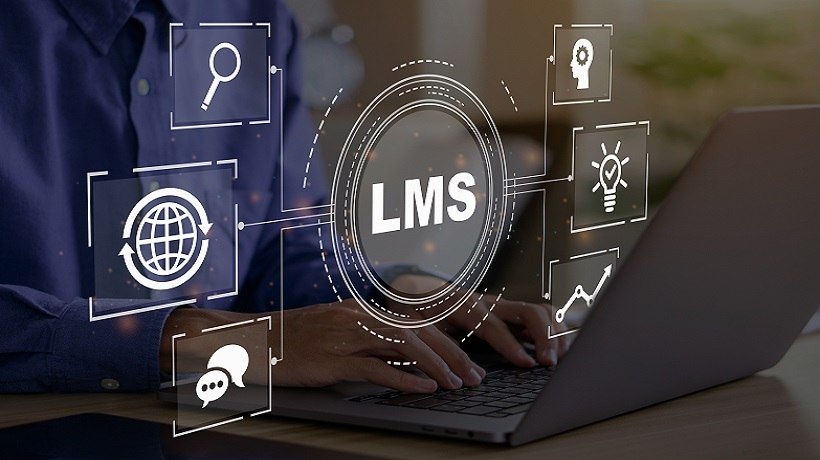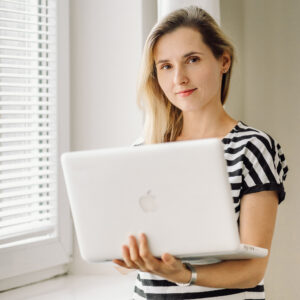...And Why You Didn't Know You Wanted It
Headless technology can be characterized by three traits: the separation of the visual (front end) and the content (back end) layers, simultaneous use of multiple front ends, and API. Let’s have a closer look at each of these traits, how they are used in eCommerce, and what their potential uses in eLearning are.
3 Traits Of Headless Technology
1. Separation Of The Front End And The Back End
Every app, portal, and any other piece of software is built out of code (also known as the back end) and a visual layer containing everything you can see and click. This visual layer, also known as the front end, is what is referred to as the "head." In traditional software architecture (called monolithic) these two parts create a whole. Headless technology separates these elements into two independent entities, communicating with each other per API.
In eCommerce, the lack of head means that every online shop can have a totally different look and not be restricted to ramifications of premade customizable templates. As no changes in the back end are necessary, the cost of such customized solutions are significantly lower than that of a shop created from scratch.
What about the implications for eLearning? The main advantage remains the same: you no longer need to rely on templates to customize your LMS. You can create your own, tailor-made looks and not only that, but you can also design particular user paths and create User Experiences totally different from other implementations of this platform. This is possible due to the fact that, while separated, the back end still contains the same set of features, while the user paths are all contained in the front end.
Influencing the front end also means influencing the accessibility standards of a platform. Accessibility standards are in a great part programmed into the front end. By having free rein over your front end design, you can decide on the level of accessibility. And that means any type of accessibility, be it WCAG 2.0 popular in European countries, or ADA, widely spread across the USA.
2. Multiple Front Ends Connected To One Back End
There is another meaning to the term "front end." It is not only the looks understood as sets of colors or page layout, but also how these looks are displayed on different devices.
In eCommerce, designing different front ends for separate sales channels and connecting them all to the very same back end means that online shops can offer the best possible User Experience to their clients, no matter whether they are using smartphones or desktops. It also allows clients to switch between the sales channels.
And what does it mean for eLearning? Basically, that every bit of training material will be perfectly displayed on any type of device included in the platform design and connected to the back end. Instructional Designers and developers won’t have to prepare separate versions of training materials for smartphones, tablets, and computers to guarantee flawless User Experience. There will be no more discussion whether the platform your organization wants to buy should be desktop or mobile first, as it will look and work perfectly on both.
3. API Communication
API (please don’t mistake it for xAPI) is what different types of software use to communicate with each other. API is inherent in headless technology. Let me underline this again: the front end and the back end are two completely separate entities. To work together they need to communicate, and they use API for that. If they communicate like this with each other, there is no reason why they shouldn’t talk to other pieces of software as well, which brings us to the third characteristic of headless technology: vast integration possibilities. eCommerce gladly uses this trait to integrate with warehouse management systems (WMS) to, among others, display real-time information on product availability on a product’s page, and with customer relationship management (CRM) systems.
As for eLearning, while certain organizations will share interest in CRM integration, they will also ask for integrating with different instances of HR, talent development, and onboarding systems, communicators and collaboration apps, internal company ecosystem…and they can get them all. As headless LMSs support all kinds of integrations, companies are no longer bound by closed lists of possible software connections when choosing an LMS provider.
Headless LMS: 2+2=5
Each of the headless LMS characteristics presented above looks very promising, to say the least, but where is the revolution I mentioned at the beginning of this article? You know what separate headless LMS characteristics can do, now let me give you a taste of what they offer when combined.
With multiple front ends and limitless integration possibilities, headless LMS platforms allow training material distribution across any number of channels and across any type of device. We are no longer restricted to creating or learning from eLearning on smartphones, tablets, and computers. Instead, we can choose SmartTVs, AR, and VR goggles, HHTs (hand-held terminals), PDAs or even intelligent fridges. And if you’re wondering about the last one: do you really think there is a better moment for a quick dietary lesson than when standing in front of an open fridge, staring at a three-day old pepperoni pizza?
Headless LMSs allow us to bring learning to completely new settings. You can learn with flip cards on your smartwatch or watch negotiations training on your SmartTV with your life partner, but you can also implement eLearning where it has been, until now, non-existent, like factories, warehouses or production halls, where neither smartphones nor laptops are used by workers on a daily basis.
With a tailor-made front end, a headless LMS can take on any look you want. This means it can also become invisible. A headless LMS is frequently searched for by software or app providers, who would like to attach a learning module to their product. On the programming side, communication via API allows to connect technologies written in different programming languages. This means you could have a CRM containing sales training materials, or a conference/event management app providing attendees with the minimal required knowledge to understand a given lecture.
Headless Technology: Not All Is Gold That Shines
While headless LMS platforms have the potential to revolutionize the way we learn, they do come with certain challenges. First of all, the initial implementation cost will be considerably higher than that of the standard LMS that offers only one look. Creating a tailor-made front end involves the work of User Experience designers, graphic designers, and front-end programmers. For such a complex project I’d throw in a PM for good measure. With so many parties involved, it increases the cost and time required.
Second, new technology calls for new training material formats. While most headless LMS platforms are SCORM compliant, please remember this: if a SCORM prepared specifically for desktop looks bad on a mobile, it will look tragic on VR goggles. This means that while you can still use a headless LMS for its integration, tailor-made looks, and User Experience, you will be limited in content distribution channels.
Third, you need to know what you want. With its unparalleled flexibility, a headless LMS can give you anything you want, but you have to name it. You need to be prepared to work closely with those responsible for creating the front end, and you need to know exactly what the platform should be integrated with and what the scope of integration should be. And that isn’t easy, especially when we are used to choosing from a preset menu.
To Sum Up
The headless technology is only just entering the eLearning sector. In my opinion it has the potential to change how we teach and how we learn. It gives us the possibility to surround ourselves with learning, without needing to enter the metaverse. It allows us to bring eLearning to places where it has been nonexistent. It is a highly specialized tool and may not meet the expectations of everyone: you don’t go for Photoshop when Paint will suffice. But it’s here, and I do believe it’s starting something new.







![eLearning Industry's Guest Author Article Showcase [January 2023]](https://cdn.elearningindustry.com/wp-content/uploads/2023/01/Shutterstock_1536652553-1.jpg)
